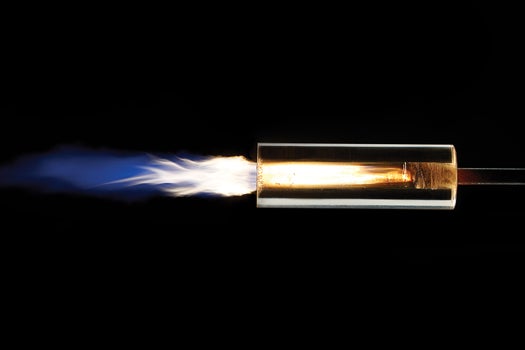Gray Matter: Watch A Hybrid Rocket Burn From The Inside Out
Seeing through a rocket engine is easier than you might think.

Space tourism front-runner Virgin Galactic hopes to launch customers toward the edge of space later this year. To get them there, in a winged craft called SpaceShipTwo, the company will light up hybrid-fuel rockets.
Hybrid-fuel engines marry two classic designs: liquid-fuel (like the space shuttle’s main engines, which combine gaseous hydrogen and liquid oxygen) and solid-fuel (like the shuttle’s boosters, which use solid aluminum and ammonium perchlorate).
Solid-fuel engines are powerful, but they burn until the fuel is gone—whether you like it or not. Pilots can throttle liquid-fuel engines, but they’re very complex machines. Hybrid-fuel engines are the in-betweens. They burn solid fuel with a liquid oxidizer, which pilots can adjust, but they are far simpler than liquid-fuel engines.

Rocket Science Continued
Learning how rocket engines work can be tricky, so wouldn’t it be cool to see through one? This is easier than you might think.
I built a transparent rocket by drilling a half-inch-wide hole through the length of a 6-inch-long by 2-inch-wide acrylic rod. That’s the whole engine: The acrylic tube is the fuel, housing, and nozzle, all in one piece. To ensure the fuel would burn rapidly, I inserted a half-inch-thick metal pipe in one end and blew pure oxygen gas through the acrylic. (Liquid oxygen would be more authentic but far more dangerous; it’s hard to handle and can lead to explosions.)
I stuck a wad of flaming paper towel into the acrylic rod to light it, then opened the oxygen-gas valve to generate a modest amount of thrust. Increasing the gas flow boosted the engine’s power, transforming a gentle pencil flame into a roaring blast.

Burnout
The rocket is hypnotic: It’s like watching a fire from the point of view of the fuel. The force of combustion drives forward ripples of gooey, burning plastic until finally, the whole cylinder starts to melt. Then it’s time to cut the gas and figure out what to do with a flaming, half-molten mass of acrylic.
Warning: Do not attempt. Burning acrylic emits toxic fumes and can cause severe burns. Oxygen gas can create powerful, unpredictable explosions.